Transformations in
Business & Economics
- © Vilnius University, 2002-2018
- © Brno University of Technology, 2002-2018
- © University of Latvia, 2002-2018
Article
THE NEOCLASSICAL MODEL OF ECONOMIC GROWTH AND ITS ABILITY TO ACCOUNT FOR DEMOGRAPHIC FORECAST
Pawel Dykas, Grzegorz Mentel, Tomasz Misiak
ABSTRACT. The main objective of this article is an attempt to develop the neo-classical growth model of Solow by repealing the assumption of a constant rate of increase in the number of employees. The authors assume that the growth path of the number of employees is equal to the product of population growth paths and the economic activity coefficient understood as the ratio of the number of employees to the size of the population. Taking into account the increase in the number of employees from the size of the population, the authors introduce the issues of demographic processes to the model. Such a modification means that the growth path of the number of employees increases asymptotically to a fixed value (resulting from the forecast) and not to infinity, as it is the case in the Solow model. In the empirical part they calibrate the parameters of the obtained model and carry out numerical simulations for the Polish economy in the period 2000-2050. In the simulation they use demographic forecasts for the Polish economy up to 2050, which shows that the population in Poland fell from 38,26 million people in 2000 to 33,95 million people in 2050. It turns out that the decline in population size does not have to have a negative impact on both the number of employees and economic growth. The Polish economy in 2000 was characterized by one of the lowest economic activity rates (τ = 0.38) among EU economies. Therefore, the study considers two scenarios for shaping the economic activity coefficient for the Polish economy: realistic when τ in the period 2000-2050 increases from 0.38 to 0.5. The adoption of τ = 0.5 in 2050 is due to Poland's average level, which characterized the economies with the highest level of this indicator among EU economies in 2016, namely: British, Dutch, German and Swedish. In the second scenario it was optimistic that the increase in τ will be 50% higher than in the first variant and in 2050 it will reach the level of 0.56 .
KEYWORDS: economic growth, demographic forecasts, labour productivity, labour infrastructure, numerical simulations, Population Forecasting.
JEL classification: J11, J20, Q40, C63.

